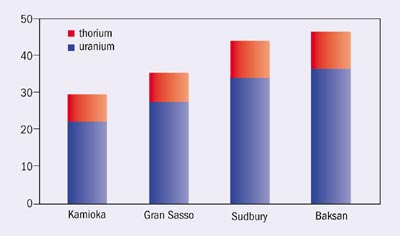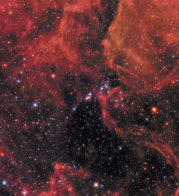One of the first applications of neutrinos to science beyond particle physics could tell us about the heat produced by radioactivity in the Earth.
More than 100 years ago, X-rays opened up a new era in medicine and science, allowing doctors “to see the man inside us”. Since the 1970s we have been using neutrinos in a similar way to monitor the “physiology” of the deep solar interior, and in 1987 neutrinos revealed the “pathological” state of a collapsing star, in supernova 1987a, heralding a new era in astronomy. Indeed, “If there are more things in heaven and Earth than are dreamt of in our natural philosophy, it is partly because electromagnetic detection alone is inadequate,” as Lawrence Krauss, Sheldon Glashow and David Schramm wrote in 1984 when they proposed a programme of antineutrino astronomy and geophysics, which would open vast new windows for exploration both above us and below.
However, unlike with X-rays, the potential of neutrino observations could not initially be fully exploited because the neutrino survival probability was not known, as testified by the 30-year-long solar neutrino puzzle. As the physics of the emission process was mixed with uncertainties in the evolution of neutrinos, it was difficult to learn much from neutrinos. But this situation changed dramatically with the results from the Sudbury Neutrino Observatory, which clearly proved the oscillation of electron neutrinos. Now we know the fate of neutrinos, so we can really learn from them. It is therefore time to tackle the kind of programme that was proposed by Krauss and colleagues, which includes a detailed study of the Sun, the cosmic abundance of the relic neutrinos from past supernovae, and last but not least the interior of the Earth.
The KamLAND experiment in Japan has already opened up a new field of research that exploits the special ability of neutrinos to reveal what is hidden to other probes of the Earth’s interior. The experiment, which confirmed neutrino oscillations by detecting antineutrinos emitted from nuclear reactors, can also discriminate events from antineutrinos of terrestrial origin, the so-called geoneutrinos (KamLAND collaboration 2003). Nine such events have been reported from the first exposure of six months, providing us with a first glimpse of the interior of the Earth.
Neutrinos and the Earth’s heat
One hundred and forty years after Jules Verne’s voyage, the deep interior of the Earth remains de facto an unexplored frontier to mankind and, despite recent progress in geological and planetary research, the number of open problems possibly exceeds the number of known facts. A central issue concerns the source of terrestrial heat. The Earth re-emits in space the radiation that comes from the Sun (1.4 kW/m2), adding to it a tiny flux of heat produced from its interior (about 80 mW/m2) to give a total of 40 TW, the equivalent of some 10,000 power plants. The origins of terrestrial heat are not understood in quantitative terms: such a heat flow can be sustained over geological times by any energy source, be it nuclear, gravitational or chemical. In the words of John Verhoogen: “Radioactivity itself could possibly account for at least 60%, if not 100%, of the Earth’s heat output…If one adds the greater rate of radiogenic heat production in the past, possible release of gravitational energy (original heat, separation of the core…), tidal friction…and possible meteoritic impact …the total supply of energy may seem embarrassingly large.” The relevant questions are: how large is the radiogenic contribution to heat flow? Which nuclei are relevant? Where are they?

The answer to which nuclei are relevant is relatively simple. The main sources of natural radioactivity are currently uranium, thorium and potassium, through the decay chains: 238U → 206Pb + 84He + 6e + 6νbar + 51.7 MeV; 232Th → 208Pb + 64He + 4e + 4νbar + 42.8 MeV; 40K + e → 40Ar + ν + 1.513 MeV (11%); 40K → 40Ca + νbar + e + 1.321 MeV (89%). Specifically they release, for natural isotopic abundances, 0.95 (uranium), 0.27 (thorium) and 3.6 x 10-5 (potassium) erg per second per gramme of the corresponding chemical element.
To answer the question about how large the radiogenic contribution is to the heat flow, we need to know the abundances of the radiogenic elements in the Earth’s different layers (figure 1), as the radiogenic heat flow depends on three basic pieces of data: the total masses of uranium, thorium and potassium, which are related to the total radiogenic heat flow H by the equation H = 9.5 MU + 2.7 MTh + 3.6 10-4 MK, where H is in TW and the masses are in units of 1017 kg. However, observational data on the amounts of uranium, thorium and potassium in the Earth’s interior are rather limited, as only the crust and the upper part of the mantle are accessible to geochemical analysis. As uranium, thorium and potassium are lithofile elements, they accumulate in the continental crust.
Estimates for the uranium mass in the crust are in the range (0.2-0.4) x 1017 kg, and while concentrations in the mantle are much smaller, the total amounts are comparable due to the much larger extension of the mantle. Estimates for the mantle are in the range (0.4-0.8) x 1017 kg. Note, however, that these estimates are much more uncertain than for the crust as they are obtained by analysing samples emerging from the upper mantle (at a depth of a few hundreds of kilometres) and extrapolating the results to the completely unexplored lower mantle (approximately 3000 km). Based on geochemical arguments, uranium should be negligible in the core, which is completely inaccessible to observation.
As for the abundance ratios, one estimates Th/U ~ 4, which is consistent with the meteoritic value, whereas for potassium one generally finds on Earth that K/U ~ 10,000, a puzzling value as it is a factor of seven below that of the oldest meteorites. The abundance of potassium in the Earth’s interior, the possibility that some is buried in the Earth’s core, and its contribution to terrestrial heat, are issues that are still debated among geochemists (Rama et al. 2003).
Geoneutrinos allow a direct and global measurement of the actual abundances of uranium, thorium and potassium, which can provide important information for discriminating among different models for heat production and, more generally, for the formation and evolution of the Earth. In fact, for each element there is a well-fixed ratio of heat to neutrinos (antineutrinos): Lνbar = 7.4 MU + 1.6 MTh + 27 x 10-4 MK; Lν = 3.3 x 10-4 MK, where the luminosities L are in units of 1024 particles per second.

The neutrinos from the Sun completely swamp those emitted from the Earth, but not so with antineutrinos. These can be detected with a distinctive signature via the inverse beta-decay reaction: νbar + p → n + e+ -1.804 MeV, which is possible with antineutrinos from the uranium and thorium chains, but not with antineutrinos from potassium. A liquid scintillator detector could record some 20-50 events from uranium and thorium geoneutrinos per kilotonne per year, depending on the assumed abundances and on the location. Geoneutrinos from uranium and thorium can be further distinguished through the different energy spectra.
The theoretical discussion of geoneutrinos was introduced in the 1960s by Gernot Eder, and extensively reviewed 20 years later by Krauss, Glashow and Schramm. Now these ideas have become more relevant. With KamLAND a handful of geoneutrino events has been extracted from the data after the subtraction of reactor and background events. The KamLAND results thus provide a first look at the amount of radiogenic material inside the Earth. In this context, a group of physicists from the universities of Cagliari and Ferrara, together with Earth scientists from Siena, has recently built a reference model for estimating neutrino fluxes according to the best geological and geochemical information (see for instance Fiorentini et al. 2003). The team has studied the possibility of detecting geoneutrinos at various underground laboratories (figure 2).
A look forward
While the KamLAND results, obtained from a short exposure, are an important first step, they are not sufficient for a determination of the geoneutrino flux and for discriminating between different models of heat production in the interior of the Earth. However, continuing observation will allow for a significant statistical increase, which will be particularly important if some nearby reactors are temporarily switched off. The comparison with measurements from Borexino at the Gran Sasso Underground Laboratories, where the reactor background is much smaller, will provide a significant addition to the data. Detectors at other underground laboratories could also make important contributions to a full map of antineutrinos from the Earth. Moreover, a detector far away from the continental crust would provide direct information on radioactivity from the mantle, which is the most uncertain issue. In principle, one could fit a detector of a few kilotonnes in a (conventionally propelled) submarine and move it around the world, at depths of a few hundred metres in an experiment lasting several years (figure 3).

Other proposals have been put forward for studying the Earth with neutrinos. For example, Ara Iaonnisian and Alexei Smirnov have considered solar neutrinos for oil prospecting. Detection would consist of measuring modulations of the 7Be flux in a large deep underwater detector-submarine that could change its location. In the 1980s, Alvaro De Rujula, Sheldon Glashow, Robert Wilson and Georges Charpak proposed using neutrinos produced by a multi-TeV proton synchrotron as a tool for geological research. Few-TeV neutrinos are suitable for “tomography” of the Earth because they have a range comparable to the Earth’s diameter. Related ideas are now being revived in the context of neutrino factories.
In 1942 Bruno Pontecorvo, one of the founding fathers of neutrino physics, published an important paper, little-known among particle physicists, in the Oil and Gas Journal, entitled “Neutron well logging – A new geological method based on nuclear physics”. It described the “neutron log”, an instrument sensitive to water and hydrocarbons that is now widely used by geologists. It clearly stemmed as an application from the celebrated studies at Rome on slow neutrons, and it testifies to Pontecorvo’s promptness in transforming basic physics into a tool that could be used in other disciplines.
Likewise, neutrinos have now reached a phase where they can be exploited in different fields of science. In this respect, the determination of the radiogenic contribution to terrestrial heat, an important and so far unanswered question, is probably the first fruit we can expect to obtain.
Further reading
F Mantovani, L Carmignani, G Fiorentini and M Lissia 2003
KamLAND collaboration 2003 Phys. Rev. Lett. 90 0210802.
V Rama et al. 2003 Nature 423 163.





